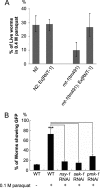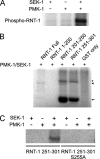Stabilization of RNT-1 protein, runt-related transcription factor (RUNX) protein homolog of Caenorhabditis elegans, by oxidative stress through mitogen-activated protein kinase pathway
- PMID: 22308034
- PMCID: PMC3323012
- DOI: 10.1074/jbc.M111.314146
Stabilization of RNT-1 protein, runt-related transcription factor (RUNX) protein homolog of Caenorhabditis elegans, by oxidative stress through mitogen-activated protein kinase pathway
Abstract
RUNX proteins are evolutionarily conserved transcription factors known to be involved in various developmental processes. Here we report a new role for a RUNX protein: a role in stress response. We show that RNT-1, the Caenorhabditis elegans RUNX homolog, is constantly produced and degraded by the ubiquitination-proteasome pathway in the intestine of the nematode. RNT-1 was rapidly stabilized by oxidative stress, and the rnt-1-mutant animals were more sensitive to oxidative stress, indicating that rapid RNT-1 stabilization is a defense response against the oxidative stress. The MAP kinase pathway is required for RNT-1 stabilization, and RNT-1 was phosphorylated by SEK-1/PMK-1 in vitro. ChIP-sequencing analysis revealed a feedback loop mechanism of the MAP kinase pathway by the VHP-1 phosphatase in the RNT-1-mediated oxidative stress response. We propose that rnt-1 is regulated at the protein level for its role in the immediate response to environmental challenges in the intestine.
Figures







Similar articles
-
Regulation of rnt-1 expression mediated by the opposing effects of BRO-1 and DBL-1 in the nematode Caenorhabditis elegans.Biochem Biophys Res Commun. 2008 Feb 29;367(1):130-6. doi: 10.1016/j.bbrc.2007.12.097. Epub 2007 Dec 26. Biochem Biophys Res Commun. 2008. PMID: 18158917
-
Identification of genes interacting with rnt-1 through large-scale RNAi screening in Caenorhabditis elegans.G3 (Bethesda). 2013 Oct 3;3(10):1779-84. doi: 10.1534/g3.113.007898. G3 (Bethesda). 2013. PMID: 23979934 Free PMC article.
-
Homologs of RUNX and CBF beta/PEBP2 beta in C. elegans.Oncogene. 2004 May 24;23(24):4346-52. doi: 10.1038/sj.onc.1207669. Oncogene. 2004. PMID: 15156192 Review.
-
The C. elegans RUNX transcription factor RNT-1/MAB-2 is required for asymmetrical cell division of the T blast cell.Dev Biol. 2005 Nov 15;287(2):262-73. doi: 10.1016/j.ydbio.2005.08.034. Epub 2005 Oct 13. Dev Biol. 2005. PMID: 16226243
-
RNT-1 regulation in C. elegans.J Cell Biochem. 2005 Sep 1;96(1):8-15. doi: 10.1002/jcb.20423. J Cell Biochem. 2005. PMID: 15988754 Review.
Cited by
-
Alterations in gene expression in Caenorhabditis elegans associated with organophosphate pesticide intoxication and recovery.BMC Genomics. 2013 Apr 30;14:291. doi: 10.1186/1471-2164-14-291. BMC Genomics. 2013. PMID: 23631360 Free PMC article.
-
Identification of a functional antioxidant response element at the HIF1A locus.Redox Biol. 2018 Oct;19:401-411. doi: 10.1016/j.redox.2018.08.014. Epub 2018 Aug 30. Redox Biol. 2018. PMID: 30241031 Free PMC article.
-
SNX-3 mediates retromer-independent tubular endosomal recycling by opposing EEA-1-facilitated trafficking.PLoS Genet. 2021 Jun 3;17(6):e1009607. doi: 10.1371/journal.pgen.1009607. eCollection 2021 Jun. PLoS Genet. 2021. PMID: 34081703 Free PMC article.
-
Dopamine-dependent, swimming-induced paralysis arises as a consequence of loss of function mutations in the RUNX transcription factor RNT-1.PLoS One. 2019 May 13;14(5):e0216417. doi: 10.1371/journal.pone.0216417. eCollection 2019. PLoS One. 2019. PMID: 31083672 Free PMC article.
-
PDR-1/hParkin negatively regulates the phagocytosis of apoptotic cell corpses in Caenorhabditis elegans.Cell Death Dis. 2014 Mar 13;5(3):e1120. doi: 10.1038/cddis.2014.57. Cell Death Dis. 2014. PMID: 24625979 Free PMC article.
References
-
- Yoshida C. A., Komori T. (2005) Role of Runx proteins in chondrogenesis. Crit. Rev. Eukaryot. Gene Expr. 15, 243–254 - PubMed
-
- Ito Y. (2008) RUNX genes in development and cancer. Regulation of viral gene expression and the discovery of RUNX family genes. Adv. Cancer Res. 99, 33–76 - PubMed
-
- Cohen M. M., Jr. (2009) Perspectives on RUNX genes: an update. Am. J. Med. Genet. Part A 149A, 2629–2646 - PubMed
Publication types
MeSH terms
Substances
LinkOut - more resources
Full Text Sources
Research Materials
Miscellaneous

